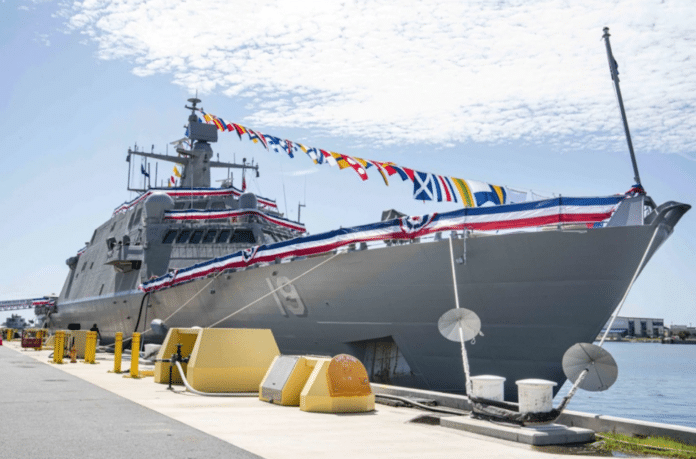The U.S. Navy commissioned Freedom-variant littoral combat ship USS St. Louis (LCS 19) on August 8 the U.S. Navy announced. Due to public health safety concerns and restrictions of large public gatherings related to the novel coronavirus (COVID-19) pandemic, the Navy commissioned St. Louis at a private event.
“Nearly 200 years after the first ship to bear the name was launched, today we commission the seventh USS St. Louis,” said Secretary of the Navy Kenneth J. Braithwaite. “Much like that sloop of war did in 1828, LCS-19 and her crew will protect the U.S. and our interests near and abroad. Whether conducting counter-narcotic operations in the Caribbean or working to enhance interoperability with partners and allies at sea, USS St. Louis will provide maneuverability, stability and lethality in today’s era of Great Power Competition.”
Adm. Craig Faller, commander of U.S. Southern Command, said littoral combat ships, like the St. Louis, have played an important role supporting operations in his command’s geographic area of focus.
“The littoral combat ship has proven to be an effective and adaptable platform capable of multiple missions in our area of responsibility,” Faller said. “It has become an end-game enabler for U.S. Coast Guard law enforcement authorities who disrupt transnational criminal organizations and the smuggling of deadly narcotics. Adding the LCS to our Enhanced Counter Narcotics Operation is helping save lives.”
St. Louis is the 22nd LCS to be delivered to the Navy, and the tenth of the Freedom-variant to join the fleet and is the seventh ship to bear the name. The first St. Louis, a sloop of war, was launched in 1828. It spent the majority of its service patrolling the coasts of the Americas to secure interests and trade. In addition, it served as the flagship for the West Indies Squadron working to suppress piracy in the Caribbean Sea, the Antilles and the Gulf of Mexico region.
The littoral combat ship is a fast, agile and networked surface combatant, and the primary mission for the LCS includes countering diesel submarine threats, littoral mine threats and surface threats to assure maritime access for joint forces. The underlying strength of the LCS lies in its innovative design approach, applying modularity for operational flexibility. Fundamental to this approach is the capability to rapidly install interchangeable mission packages (MPs) onto the seaframe to fulfill a specific mission and then be uninstalled, maintained and upgraded at the Mission Package Support Facility (MPSF) for future use aboard any LCS seaframe.
Participating in the ceremonial flyover for the commissioning of the Navy’s newest littoral combat ship included two MH-60R, assigned to Helicopter Maritime Strike Squadron (HSM) 60 and HSM-70, based out of Naval Air Station (NAS) Jacksonville. Primary missions of the MH-60R include Anti-Submarine Warfare, Anti-Surface Warfare, Surveillance, Communications Relay, Combat Search and Rescue, Naval Gunfire Support and logistics support.
When the USS St. Louis is paired with world’s most advanced maritime helicopter, the MH-60R, it will have a robust anti-submarine mission capability that is fully interoperable with the U.S. Navy and its coalition partners.



